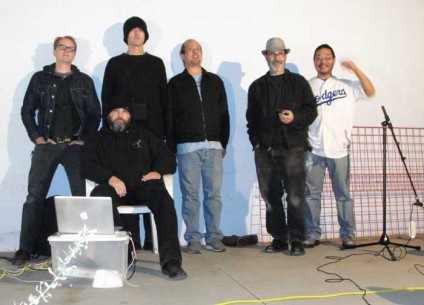1. The members of Southern California Sound Ecology (SCSE) come from a range of different musical perspectives and backgrounds, from noise to “slow sound” (which is related to lowercase)….how did you come together to form SCSE? How do the different approaches inform the group as a whole?
Jorge Martin: It could be that each member (past, present, future) of the ensemble has their own historical perspective of how the SCSE formed, but I credit Glenn Bach for its start and organization. I met him and the others in the group at various festivals/performances that Glenn curated (Slow Sound Festival, So.Cal.Sonic, Quiet, etc). I know at one point, he became involved with the American Society for Acoustic Ecology and had his own project where he recorded/documented sounds on his morning walks. Eventually, Glenn proposed a meeting/salon to discuss Sound Ecology and this lead to the formation of a sound ecology based ensemble.
I am not sure how much our musical backgrounds/perspectives inform the group. I’m sure it does to an extent, but the main force/energy behind the ensemble is each member’s individual aural awareness/sensitivity and the acoustic environments we each are immersed in.
2. Can you talk a bit about “Acoustic Ecology” and why you feel the work in this field is important and how SCSE fits in? What are some of the key works for you?
JM: Ecology, in general, involves the observation and analysis of interactions between an organism and its environment (climate, topography, geography, population, etc). One pathway of interaction is via the stimulation of the senses. The sonic environment can have a profound impact. I get really tense when I hear a navy jet screaming overhead and hypnotized by the whirr of hummingbirds in flight. One important aspect of acoustic ecology is to elucidate a correlation between sound and human psychology/behavior.
What each member of the SCSE does is prepare and playback their own field recordings while listening to the others in the ensemble to create a really cool collage of sounds. So SCSE’s part in acoustic ecology is the recording (documentation) and playback/performance of collected sounds
3. Individually, what are you all listening to these days?
JM: I usually don’t listen to anything, unless I have to. During my commute to and from work, I listen to people talking on the radio. At the lab, I listen to all the machines make unusual sounds. After listening to my own thoughts throughout the day, I am too burned out to listen to anything else.
4. How is the Baldwin Hills Scenic Overlook location influencing your approach to the performance?
JM: My thought would be to record and use sounds from the BHSO. I did spend some time at the park and found the recordings not as interesting as I had hoped. There were too many people, very loud traffic and strong winds (which clipped many of the tracks). The interesting sounds unique to the park were drowned out by people and wind.
However, we plan to sample sounds during the day of the show. If possible, we will also incorporate recordings of the other two performances on Sunday.
5. What’s next for SCSE?
JM: I am not sure. We’re not a traditional ensemble. We don’t get together to rehearse or plan out the ensemble’s future. What normally happens is that one of us will be aware of an upcoming event and we put the word out and gauge everyone’s interest.
5.5 Choose a track from our archive, and tell us why you chose it (in as few or many words as you like).
JM: The track is choose is…. Voice of the Bowed Guitar/sound. at the Schindler House.
Why? I love Rod Poole’s music. I really enjoy listening to this Voice of the Bowed Guitar piece. I close my eyes and focus on the resonant sounds and the constructive/destructive interference of the sound waves. It’s hypnotic. I really miss him.
